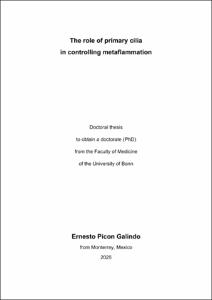Picon Galindo, Ernesto: The role of primary cilia in controlling metaflammation. - Bonn, 2025. - Dissertation, Rheinische Friedrich-Wilhelms-Universität Bonn.
Online-Ausgabe in bonndoc: https://nbn-resolving.org/urn:nbn:de:hbz:5-81028
Online-Ausgabe in bonndoc: https://nbn-resolving.org/urn:nbn:de:hbz:5-81028
@phdthesis{handle:20.500.11811/12811,
urn: https://nbn-resolving.org/urn:nbn:de:hbz:5-81028,
doi: https://doi.org/10.48565/bonndoc-505,
author = {{Ernesto Picon Galindo}},
title = {The role of primary cilia in controlling metaflammation},
school = {Rheinische Friedrich-Wilhelms-Universität Bonn},
year = 2025,
month = feb,
note = {The primary cilium is a cellular antenna that senses and integrates external stimuli. Its composition is regulated by specialized proteins, such as BBS proteins, and mutations in any of the genes that encode BBS proteins cause a rare disease called the Bardet-Biedl syndrome (BBS). Although most patients with BBS develop a severe form of central obesity, their metabolic outcomes per se seems to be better than in patients with non- syndromic obesity. Obesity-triggered inflammation, known as metaflammation, is a key player in cardiometabolic diseases; however, the regulatory mechanisms remain ill- defined. I hypothesized that BBS patients are protected from developing metaflammation and, thereby, obesity-related metabolic disorders. To address that, I performed deep immunophenotyping of BBS patients using high-dimensional flow cytometry and multi- omics analyses in a nationwide cohort of patients and compared the results to non- syndromic obese patients as well as matching healthy controls. To gain mechanistic insight, I analyzed different global and cell-specific BBS mouse models and performed in vitro assays. I identified genotype-dependent differences in the metabolomic and lipidomic profile as well as in circulating concentrations of metaflammation-related cytokines among BBS patients, indicating a healthy obesity phenotype in BBS1 patients, but not in others. The differences were mirrored by changes in the circulating Treg cells, pointing towards an “anti-inflammatory” phenotype in BBS1 patients, exerted by an expanded Treg cell pool. By examining the underlying molecular mechanisms in an obese BBS mouse model (Bbs8KO) that resembles the phenotype of BBS1 patients, I demonstrated that these mice showed an expansion of Treg cells in the visceral adipose tissue, which is linked with an enhanced metabolic function. These differences occurred already at an early age in the thymus during Treg development, driven by thymic epithelial cells (TECs), which regulate Treg cell development. Taken together, I demonstrated that BBSome-dependent signaling in TEC cells controls Treg development. Loss BBSome function promotes Treg expansion, which exerts an immunomodulatory effect during obesity, ameliorating metaflammation.},
url = {https://hdl.handle.net/20.500.11811/12811}
}
urn: https://nbn-resolving.org/urn:nbn:de:hbz:5-81028,
doi: https://doi.org/10.48565/bonndoc-505,
author = {{Ernesto Picon Galindo}},
title = {The role of primary cilia in controlling metaflammation},
school = {Rheinische Friedrich-Wilhelms-Universität Bonn},
year = 2025,
month = feb,
note = {The primary cilium is a cellular antenna that senses and integrates external stimuli. Its composition is regulated by specialized proteins, such as BBS proteins, and mutations in any of the genes that encode BBS proteins cause a rare disease called the Bardet-Biedl syndrome (BBS). Although most patients with BBS develop a severe form of central obesity, their metabolic outcomes per se seems to be better than in patients with non- syndromic obesity. Obesity-triggered inflammation, known as metaflammation, is a key player in cardiometabolic diseases; however, the regulatory mechanisms remain ill- defined. I hypothesized that BBS patients are protected from developing metaflammation and, thereby, obesity-related metabolic disorders. To address that, I performed deep immunophenotyping of BBS patients using high-dimensional flow cytometry and multi- omics analyses in a nationwide cohort of patients and compared the results to non- syndromic obese patients as well as matching healthy controls. To gain mechanistic insight, I analyzed different global and cell-specific BBS mouse models and performed in vitro assays. I identified genotype-dependent differences in the metabolomic and lipidomic profile as well as in circulating concentrations of metaflammation-related cytokines among BBS patients, indicating a healthy obesity phenotype in BBS1 patients, but not in others. The differences were mirrored by changes in the circulating Treg cells, pointing towards an “anti-inflammatory” phenotype in BBS1 patients, exerted by an expanded Treg cell pool. By examining the underlying molecular mechanisms in an obese BBS mouse model (Bbs8KO) that resembles the phenotype of BBS1 patients, I demonstrated that these mice showed an expansion of Treg cells in the visceral adipose tissue, which is linked with an enhanced metabolic function. These differences occurred already at an early age in the thymus during Treg development, driven by thymic epithelial cells (TECs), which regulate Treg cell development. Taken together, I demonstrated that BBSome-dependent signaling in TEC cells controls Treg development. Loss BBSome function promotes Treg expansion, which exerts an immunomodulatory effect during obesity, ameliorating metaflammation.},
url = {https://hdl.handle.net/20.500.11811/12811}
}





